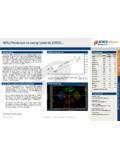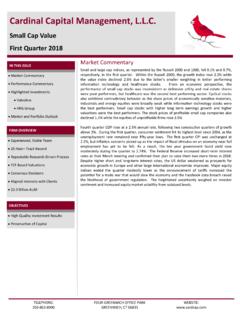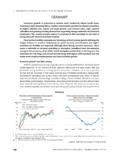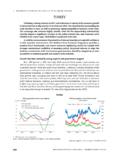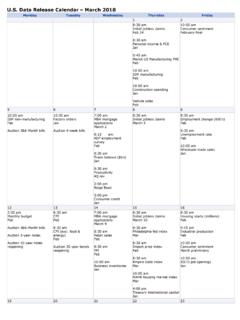Transcription of Outline
1 Afrinvest West Africa Page 2 Outline Section 1 Executive Summary 04 Section 2 Global Economy and Financial Markets Review and Outlook 14 Synchronised Global Growth Expansion to Continue Despite Policy Stability Risks 15 Policy Normalization by Systemic Central Banks Remains Downside Risk to EMs & DEs Growth 16 Global Markets: Consensus Opinion Points to Further Gains against Strong Macro Backdrop 16 Section 3 Domestic Macroeconomic Review and Outlook 17 The Recession and its Aftermath 18 Business Cycle Turnaround: Cyclical Oil Earnings Upswing Masks Structural Reform Inertia 19 2018 Macroeconomic the Recovery 22 Section 4 Equities Market Review and Outlook 29 Equites Market Performance and Outlook A possible Game of Two Halves?
2 30 Sector Based Rally Recorded across Sectors 31 Our Scenario Analysis in 2018 32 Equities Market Prognoses for Era of Happy-go-lucky Trading to Fizzle Out 35 Section 5 Fixed Income Market Review and Outlook 37 Sustained Tight Monetary Policy Bolstered Activity in Fixed Income Market 38 Fixed Income Market Prognoses in Overall Activity Should Favour Optimal Return 41 Section 6 Alternative Asset Classes 43 Real Estate Market Review and Outlook 44 Derivatives Market Review and Outlook 46 Global Commodities Review and Outlook 49 Section 7 Investment Strategy for 2018 53 Consumer Goods Portfolio 55 Banking Quality Portfolio 56 Short-Term Dividend Income Portfolio 56 Long-Term Dividend Portfolio 57 Sentiment Portfolio 57 Smart Eurobond Portfolio 57 Afrinvest West Africa Page 3 Outline Low Risk Aggressive Portfolio 58 High Return Long-Bond Portfolio 58 Passive Bond Portfolio 59 Section 8 List of Charts, Tables and Figures 60 Section 9 Afrinvest (West Africa) Limited 63 Contact 64 Disclaimer 65 Nigerian Economic & Financial Market Outlook 2018 Page 4 Executive Summary Section One Afrinvest West Africa Page 5 Executive Summary Global Macroeconomic Highlights The global economy continued to record synchronised expansion across regions in 2017.
3 This has been supported by sustained momentum in Advanced Economies (AEs), brought about by favourable financial conditions and cyclical recovery in the Euro Area, resilient growth in China and rebound in frontier markets propped by increase in commodity prices. The strong and synchronised global growth upswing is expected to continue into 2018, with the IMF revising 2018 forecast upward by to in October 2017 and to in January 2018. Nevertheless, while near term global growth prospects remains broadly positive, increasing geo-political risk, trade protectionism and policy normalization by systemic central banks are downside risks to forecasts. Likewise, as the move towards normalization strengthens in 2018, supported by favourable labour market conditions and increased momentum in global growth, systemic central banks in developed markets would be more willing to begin monetary policy tightening despite sticky inflation.
4 As central banks gradually normalize monetary policy from the extraordinary measures taken at the peak of the global economic and financial crisis, associated downside risks of tightening global liquidity and capital flow reversals from emerging & frontier markets and currency volatility will become more prominent headwinds to near term growth and financial market stability. Domestic Macroeconomic Highlights The year 2017, in many respects, was a year of recovery for the Nigerian economy and financial market compared to the sharp business cycle contraction witnessed in 2016 alongside weak market returns. Consequent on the upturn in commodity prices, cessation of attacks on oil & gas infrastructure in the Niger Delta region (which had a positive knock-on impact on domestic crude oil production volume) and adoption of pro-market FX reforms by the Central Bank of Nigeria (CBN), economic activity rebounded while investor and consumer confidence as well as business sentiments strengthened.
5 The Nigerian economy returned to growth in Q2:2017, exiting a 4-Quarter long recession - its first in 25 years which lasted between Q2:2016 and Q1:2017. Propped by higher oil exports and administrative flexibility in FX management structure, reflected in increased CBN FX Interventions and opening of the Investors and Exporters (I&E) FX Window in April 2017, external sector indicators also turned positive with the Current Account Surplus jumping nearly four times from US$ in 2016 to US$ in 2017 while cumulative Capital Importation as of 9M:2017 rose Y-o-Y to a 2-year high of US$ The favourable Balance of Payment dynamics led to accumulation in External Reserves which climbed to a 3-year high of US$ (29/12/2017) and stabilized the Naira at the official window with a consequential impact on the parallel market which gained Y-o-Y against the greenback to close at $ by yearend.
6 Supported by improved growth prospects and FX liquidity, business sentiment, gauged by the CBN s Manufacturing and Non-Manufacturing Purchasing Managers Indices (PMI), indicated expansion in activity from April 2017 till date. Consumer Confidence has also been on the rise, with the NOI (Ngozi Okonjo Iweala) Polls survey showing a points increase in its Consumer Confidence Index from points in Q1:2017 to points in Q3:2017. The strong and synchronised global growth upswing is expected to continue into 2018, with the IMF revising 2018 forecast upward by to in October 2017 and to in January 2018. Although price level growth disappointed for much of the year, persistently falling below Analysts estimates, due to pressures on food prices, Headline Inflation measured Year-on-Year (Y-o-Y)
7 , moderated to in December 2017 while the Core measure of prices fell within the same period to Page 6 Nigerian Economy & Financial Market Outlook 2018 Executive Summary Although price level growth disappointed for much of the year, persistently falling below Analysts estimates, due to pressure on food prices, Y-o-Y Headline Inflation moderated to in December 2017 while the Core Inflation fell within the same period to Labour market slack was the only blot on the strong improvement in core macro variables as the economy struggled to create jobs for the expanding labour force, forcing Unemployment and Underemployment rates to rise and to and respectively in Q3:2017. On the back of the strong oil price tailwind, our near term prognoses for macroeconomic indicators are broadly positive as we expect the economy to consolidate on recent recovery.
8 Price Benign Outlook as Policy Makers Hold-off on Supply Side Reforms Unlike 2016 when the spike in food prices pressured the Consumer Price Index (CPI), the major risk-factor for Consumer Prices in 2018 will be coming from the Core Index where delayed supply-side reforms in regulated markets for Power and Fuel could destabilize prices. The Power sector is currently facing a liquidity crunch due to non-cost reflective tariffs and lack of investment in the value chain to ease high Aggregate Technical, Commercial and Collection (ATC&C) losses, resulting in demand for increase in tariff by value chain operators. Furthermore, the Price-Modulation template for pricing of PMS (Petroleum Motor Spirit) introduced by the Petroleum Products Pricing Regulatory Agency (PPPRA) in May 2016, in retrospect, is akin to putting Band-Aid on a bleeding artery rather than a landmark reform to liberalise the downstream industry as earlier guided.
9 Already, assumptions included in the template are urgently due for upward review on the back of the increase in the landing cost of PMS following the oil price rally and the June-2016 Naira devaluation. Despite these risk factors, our near-term inflation outlook remains benign due to constrained political will to implement supply side reforms ahead of the 2019 elections. Supportive oil earnings tailwind will also buy the federal government more time to contemplate the reforms. Hence, our base-case scenario projects Headline Inflation moderating further to by yearend 2018. Near Term Growth Outlook .. Oil Sector Low Base Effect Will Remain Key Driver The economy s return to growth in Q2:2017 and acceleration in momentum in Q3 were largely driven by Oil sector GDP which grew and Y-o-Y in Q2:2017 and Q3:2017 respectively.
10 The sizeable expansion in the Oil sector, particularly in Q3:2017, was due to the low base effect of oil sector production which reached a 6-Quarter high of during the period. The Non-Oil sector however remains a pressure point, as it relapsed to negative growth in Q3 after showing positive signs in Q1 and Q2. The disappointing performance of the Non-Oil sector - which was unexpected given the positive readings from leading variables such as the PMI - is evident in virtually all the main Non-Oil categories including Services and Manufacturing which contracted and Y-o-Y respectively in Q3:2017. The slow recovery of the Non-Oil sector has both cyclical and structural explanations. Cyclical factors include tight monetary policy, subsisting weak fiscal spending particularly at sub-national level - low real household consumption growth (due to high inflation rate) and benign corporate investment spending consequent on the damaging impact of large FX rate movements in the last 3 years on corporates balance sheet.

